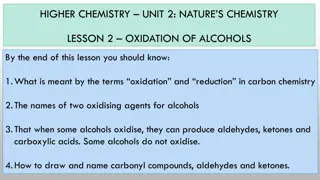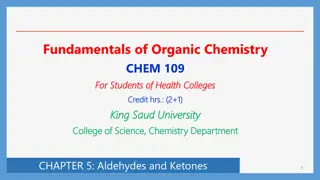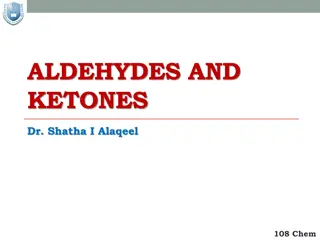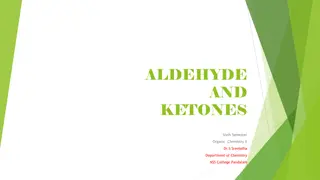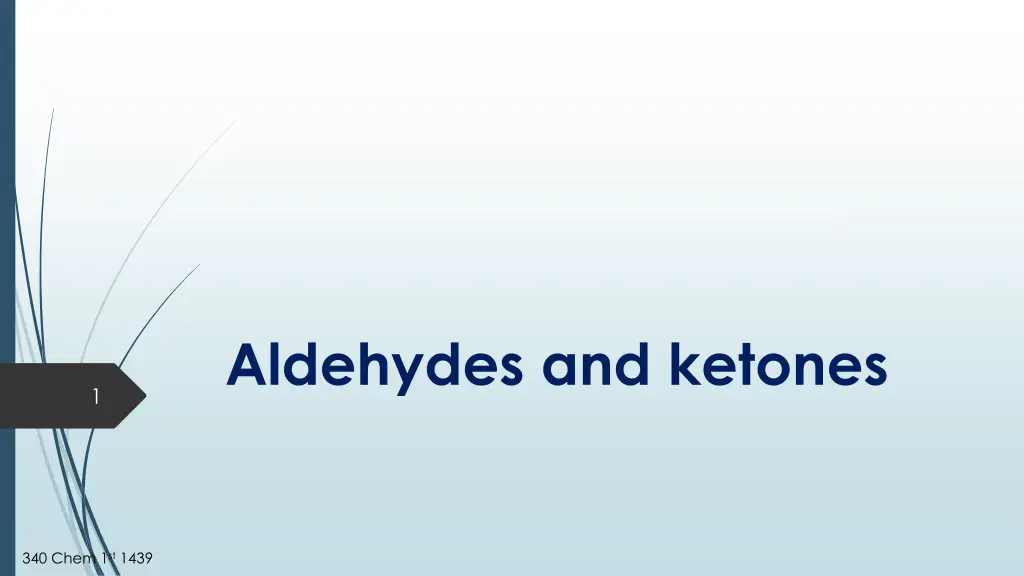
Understanding Aldehydes and Ketones in Chemistry
Explore the structure, bonding, nomenclature, physical properties, preparation, and reactions of aldehydes and ketones. Learn about the distinct functional groups, common names, IUPAC nomenclature, and examples of these organic compounds found in nature. Dive into the world of aromatic aldehydes and ketones with vivid descriptions and chemical structures.
Download Presentation

Please find below an Image/Link to download the presentation.
The content on the website is provided AS IS for your information and personal use only. It may not be sold, licensed, or shared on other websites without obtaining consent from the author. If you encounter any issues during the download, it is possible that the publisher has removed the file from their server.
You are allowed to download the files provided on this website for personal or commercial use, subject to the condition that they are used lawfully. All files are the property of their respective owners.
The content on the website is provided AS IS for your information and personal use only. It may not be sold, licensed, or shared on other websites without obtaining consent from the author.
E N D
Presentation Transcript
Aldehydes and ketones 1 340 Chem 1st 1439
2 Outline Structure and Bonding Nomenclature Physical Properties Preparation Reactions 340 Chem 1st 1439
Structure and Bonding 3 The functional group of an aldehyde is a carbonyl group bonded to a hydrogen atom and a carbon atom The functional group of a ketone is a carbonyl group bonded to two carbon atoms Many compounds found in nature have aldehyde or ketone functional groups. Aldehydes have pungent odors, whereas ketones tend to smell sweet. Vanillin and cinnamaldehyde are examples of naturally occurring aldehydes. A whiff of vanilla extract will allow you to appreciate the pungent odor of vanillin. The ketones camphor and carvone are responsible for the characteristic sweet odors of the leaves of camphor trees, spearmint leaves, and caraway seeds. 340 Chem 1st 1439
4 340 Chem 1st 1439
IUPAC Nomenclature of aldehyde 5 Select the longest chain of carbon atoms that contains the functional group. changing the suffix -e of the parent alkane to al. Number must start with carbonyl group of an aldehyde as carbon-1. For unsaturated aldehydes, the presence of a carbon-carbon double or triple bond is indicated by the infix -en- or -yn-. As with other molecules with both an infix and a suffix, the location of the group corresponding to the suffix determines the numbering pattern. The functional group priority order in nomenclature system is as following: Acid and derivatives > aldehyde > ketone > alcohol > amine > alkene > alkyne > ether For cyclic molecules in which }CHO is bonded directly to the ring, the molecule is named by adding the suffix -carbaldehyde to the name of the ring. The atom of the ring to which the aldehyde group is bonded is numbered 1. 340 Chem 1st 1439
The common name for an aldehyde is derived from the common name of the corresponding carboxylic acid by dropping the word acid and changing the suffix -ic or oic to -aldehyde. 6 In common names carbon atoms near the carbonyl group are often designated using Greek letters ( , , , ..) beginning with carbon next the carbonyl group. 3-Methylbutanal Butanal a a (?- 340 Chem 1st 1439
7 340 Chem 1st 1439
Br 8 O O O O O2N p-Nitro-benzaldehyde 4-Nitro-benzaldehyde Cyclohexanecarbaldehyde -Bromo- -methyl butyraldehyde p-Methyl-benzaldehyde p-Tolualdehyde 4-Methyl-benzaldehyde 3-Bromo-2-methyl-butanal O O OH O O Cl H3CO p-Methoxy-benzaldehyde Anisaldehyde 4-Methoxy-benzaldehyde -Chloro- -ethyl valeraldehyde 3-Chloro-2-ethyl-pentanal -Phenyl-acetaldehyde 2-Phenylethanal Salicylaldehyde o-Hydroxy-benzaldehyde 2-Hydroxy-benzaldehyde O O O COOH O HO O O OH 3-Hydroxypopanal benzene carbaldehyde 2-Formylbenzoic acid 3,4-Dioxobutanoic acid 340 Chem 1st 1439
IUPAC Nomenclature of Ketone 9 ketones are named by selecting as the parent alkane the longest chain that contains the carbonyl group changing the suffix from -e to one The parent chain is numbered from the direction that gives the carbonyl carbon the smaller number. If a ketone has a second functional group of higher naming priority, the ketone oxygen is indicated by the prefix oxo. Common names for ketones are derived by naming the two alkyl or aryl groups bonded to the carbonyl group as separate words followed by the word ketone. A ketone or aldehyde group can also be named as a substituent on a molecule with a higher priority functional group as its root. A ketone or aldehyde carbonyl is named by the prefix oxo- if it is included as part of the longest chain in the root name. When an aldehyde group is a substituent and not part of the longest chain, it is named by the prefix formyl. Carboxylic acids frequently contain ketone or aldehyde groups named as substituents. 340 Chem 1st 1439
10 Phenyl ethanone Diphenylmethanone Dimethyl Ketone 340 Chem 1st 1439
11 340 Chem 1st 1439
12 340 Chem 1st 1439
Physical Properties 13 Oxygen is more electronegative than carbon; therefore, a carbon-oxygen double bond is polar, with oxygen bearing a partial negative charge and carbon bearing a partial positive charge. In general, aldehydes and ketones have higher boiling points than alkenes because they are more polar and the dipole dipole attractive forces between molecules are stronger. But they have lower boiling points than alcohols because, unlike alcohols, two carbonyl groups can t form hydrogen bonds to each other. Aldehydes and ketones can form hydrogen bonds with the protons of OH groups. This makes them more soluble in water than alkenes, but less soluble than alcohols. 340 Chem 1st 1439
14 CH3CH2CH2CH3 CH3OCH2CH3 CH3CH2CHO CH3COCH3 CH3CH2CH2OH Butane methoxyethane propanal acetone propan-1-ol bp 0 C bp 8 C bp 49 C bp 56 C bp 97 C 340 Chem 1st 1439
Syntheses of Ketones and Aldehydes Oxidation of Alcohols 15 Sodium dichromate in sulfuric acid ( chromic acid, H2CrO4) is the oxidizing reagent for secondary alcohols to ketones. Bleach (NaOCl sodium hypochlorite) is an inexpensive. Primary alcohols are usually oxidized by Pyridinium chlorochromate (PCC), a complex of chromium trioxide CrO3 with pyridine and HCl, provides good yields of aldehydes 340 Chem 1st 1439
Ozonolysis of Alkenes 16 340 Chem 1st 1439
17 340 Chem 1st 1439
FriedelCrafts Acylation 18 340 Chem 1st 1439
Hydration of Alkynes 19 340 Chem 1st 1439
Reactions of aldehydes and Ketones 20 Nucleophilic Addition to the Carbon Oxygen Double Bond 340 Chem 1st 1439
Addition of Grignard Reagents 21 340 Chem 1st 1439
Reduction of carbonyl group Addition of metal hydrides( formation of alcohol) 22 O 1) LiAlH4 or NaBH4 2) H3O+ R R CH2 OH H O OH 1) LiAlH4 or NaBH4 2) H3O+ R R CH R` R` O H 2H2 / Pt O 1) NaBH4 2) H2O O H 340 Chem 1st 1439
The Addition of Alcohols: Hemiacetals and Acetals 23 R R R + R ` ` ` O H H ` R O R ` ` ` R O R ` ` + R ` ` O H ` R O + H O H i a c e t a l A c e t a l O R ` ` ` R R ` = H ` = a l k y l K e t o n e A l d e h y d e H e m O C 2H O H + 5 H C 2H 5O H C 2H 5O H H y d r o l y s i s + 2 C 2H 5O H + O O C 2H O C 2H O 5 5 + H H e m i a c e t a l A c e t a l + O C 2H O H H 5 C 2H 5O H C 2H 5O H H y d r o l y s i s + 2 C 2H 5O H + O O O C 2H O C 2H 5 5 + H H H e m e m i K e t a l o l d i a c e t a l n e w K e t a l o l d A c e t a l n e w 340 Chem 1st 1439
Addition of Hydrogen Cyanide: Formation of cynohydrins 24 R R +HCN Cyanohydrine `R OH `R O CN CN CH2NH2 H2 / Pt OH O +HCN OH or LiAlH4 and H3O+ Benzaldehyde cyanohydrine COOH CN O H3O+ OH OH +HCN heat 340 Chem 1st 1439
Addition of acetylide ions: 25 R R H3O+ + `R R`` ``R CNa `R O OH OH O H3O+ + CNa 340 Chem 1st 1439
Addition of Ammonia and Ammonia Derivatives 26 N H N H3 Im in e O H N H2O H N O x im e O H y d ro x y a m in e N H2 H2N -N H2 N H y d ra z o n e H y d ra z in e 340 Chem 1st 1439
Oxidation of Aldehydes 27 H OK o r K 2 C M n O 4 r 2 O 7R r A r C O O H C O O H o R - C H O o rA r - C Iodoform reaction: The reaction occurs in any aldehyde or ketone containing CH3CO. ONa +3 NaI +3 I2 +CHI3 +4 NaOH R O R O I2 / NaOH CHI3 COONa + O 340 Chem 1st 1439
28 340 Chem 1st 1439
Cannizaro Reaction 29 B) Hydride shift: The tetrahedral intermediate I , expels a hydride ion as a leaving group and is thereby oxidized. A second aldehyde molecule accepts the hydride ion in another nucleophilic addition step and is thereby reduced. A) Nucleophilic addition of an OH - ion to the 1st aldehyde molecule gives a tetrahedral intermediate. A B 340 Chem 1st 1439
Aldol condensation: 30 340 Chem 1st 1439
Tollens Test 31 Tollens reagent oxidizes an aldehyde into the corresponding carboxylic acid. The reaction is accompanied by the reduction of silver ions in Tollens reagent into metallic silver, which, if the test is carried out in a clean glass test tube, forms a mirror on the test tube. Ketones are not oxidized by Tollens reagent, so the treatment of a ketone with Tollens reagent in a glass test tube does not result in a silver mirror. 340 Chem 1st 1439

